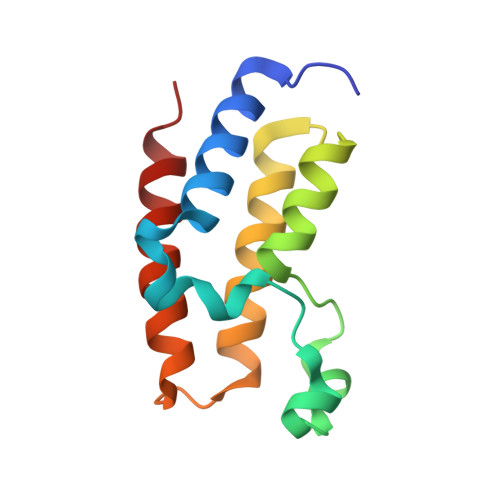Cancer Differentiating Agent Hexamethylene Bisacetamide Inhibits Bet Bromodomain Proteins.
Nilsson, L.M., Green, L.C., Muralidharan, S.V., Demir, D., Welin, M., Bhadury, J., Logan, D.T., Walse, B., Nilsson, J.A.(2016) Cancer Res 76: 2376
- PubMed: 26941288
- DOI: https://doi.org/10.1158/0008-5472.CAN-15-2721
- Primary Citation of Related Structures:
5A7C - PubMed Abstract:
Agents that trigger cell differentiation are highly efficacious in treating certain cancers, but such approaches are not generally effective in most malignancies. Compounds such as DMSO and hexamethylene bisacetamide (HMBA) have been used to induce differentiation in experimental systems, but their mechanisms of action and potential range of uses on that basis have not been developed. Here, we show that HMBA, a compound first tested in the oncology clinic over 25 years ago, acts as a selective bromodomain inhibitor. Biochemical and structural studies revealed an affinity of HMBA for the second bromodomain of BET proteins. Accordingly, both HMBA and the prototype BET inhibitor JQ1 induced differentiation of mouse erythroleukemia cells. As expected of a BET inhibitor, HMBA displaced BET proteins from chromatin, caused massive transcriptional changes, and triggered cell-cycle arrest and apoptosis in Myc-induced B-cell lymphoma cells. Furthermore, HMBA exerted anticancer effects in vivo in mouse models of Myc-driven B-cell lymphoma. This study illuminates the function of an early anticancer agent and suggests an intersection with ongoing clinical trials of BET inhibitor, with several implications for predicting patient selection and response rates to this therapy and starting points for generating BD2-selective BET inhibitors. Cancer Res; 76(8); 2376-83. ©2016 AACR.
Organizational Affiliation:
Department of Surgery, Institute of Clinical Sciences, Sahlgrenska Cancer Center at University of Gothenburg, Gothenburg, Sweden.























